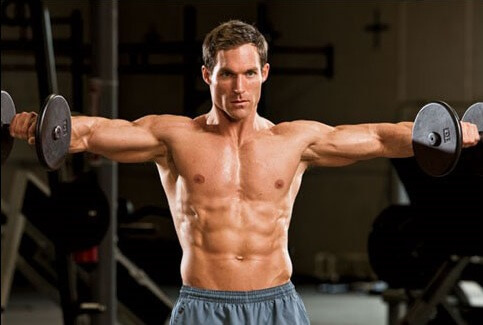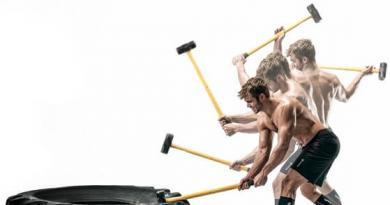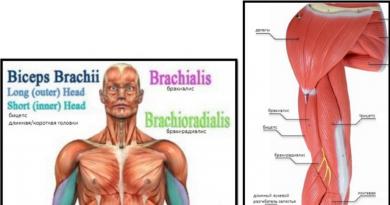Article content:
What muscles will work during this exercise. Basics and nuances of competent technology, useful tips.
The first thing that distinguishes a well-pumped torso is massive shoulders. In this case, the main formative role is played by the middle bundle of deltas. To work it out, an effective and easy-to-perform exercise has been created - swinging dumbbells to the sides.
What are its features? What are the possible errors? How to perform swings correctly? These and a number of other points are discussed in this article.
Feature of the exercise and errors
As already mentioned, when performing swings, the load falls on the middle deltas. Proper technique guarantees the spherical shape of the shoulders, forming them in width. The middle and posterior bundle of the deltoid muscles create a visual massiveness of the torso, attract the eyes of the opposite sex and make the body more aesthetic. But, despite the popularity of the exercise, there are not so many owners of wide shoulders. The reasons are incorrect execution and gross errors in technology.
Standing dumbbell swings are only at first glance a technically simple exercise. In practice, it is worth learning to coordinate movements, feel the body, ensure full muscle contraction, exclude the work of additional groups, and so on. The main thing is to guarantee “isolation”, that is, fix the limbs in the elbow part and not bend the arms during the entire approach. If performed correctly, the desired muscle will definitely grow.
Key mistakes:
- Cheating. The main problem for beginners is the race for large weights. It should be understood that an excessive load excludes the possibility of a proper study of the shoulder girdle. The athlete inevitably connects the trapezoid, the muscles of the arms and back to work - jerks, casts, swings, and so on begin. In such a situation, it is unrealistic to get an increase in deltas. To achieve hypertrophy, contractions must be carried out under the influence of an average load in a small time period.
- Throwing the elbow joint above the shoulders. Do not try to "fly up" when doing the exercise. If you raise your elbows above the shoulder joint, then it is easier to achieve growth not of the middle delta, but of the trapezium. The latter is more massive and takes the load. Having captured a lot of weight, you will work it out, and your shoulders will remain intact.
- High execution speed. Haste in bodybuilding never leads to a result. The only thing that increases is the risk of injury. Work at a moderate pace, take your time. The main task is to feel the work of the middle delta, to provide the highest level of load.
- Bringing hands forward. Try to keep them on the same level with the torso. When carrying the load forward, you risk losing balance.
To avoid the described errors, it is worth remembering a simple technique. Imagine that not dumbbells are clamped in your hands, but jugs filled with liquid. The main goal is to spread the "jugs" as if you are gradually pouring water - that is, the little fingers will be higher than the rest of the fingers.
Technique: the main rules
For the correct execution of the swings, proceed as follows:
- Get on a flat surface. Spread your feet so that they are slightly wider than your shoulders, toes apart. Watch your back - it should be flat, slightly bend the torso forward. Bend your arms slightly at the elbow joint and lock in this position. The average angle is 120 degrees. Do not raise your shoulders - they should be lowered throughout the exercise. Grip the dumbbells tightly (palms "look" at the hips). Make sure that they lightly touch the legs (no need to rest against them). Bend your knees slightly to keep your balance during the approach.
- As soon as the starting position is occupied, start moving the dumbbells to the sides. Make sure that the elbows do not move out of position. In the process of lifting the load, the little finger should be turned up. As soon as the elbow joint has reached the level of the shoulder, it is worth fixing in this position and, together with the exhalation, lower the hands down until they touch the thigh.
- Pay attention to your breath. At the moment of lowering, smoothly release the air from the lungs, and after the dumbbells touch the thigh, immediately begin a new cycle. Please note that the return movement of the arms is carried out slowly, with control of the load at each of the points. At this stage, many try to bend the elbow joints - you should not do this.
- Try to keep your lower back tense and your torso straight.
The execution technique is correct if during the approach there is a feeling of the middle delta, and its stretching at the bottom point is felt physically. The effect is also visible visually - the muscle bundle is filled with blood and begins to stand out against the background of other groups. To improve the result and work out the muscle of a certain arm, alternate execution is allowed. This option is also suitable for beginners who have not mastered the technique.
When performing swings, it is worth considering a number of tips:
- Choose your working weight wisely. If you overestimate the load, then the upper back (trapezium) is connected to the work. We have already mentioned that in such a situation, the back takes the main load, and the deltas remain out of work. Also, overweight causes the elbow to bend more than the prescribed 120 degrees, which automatically reduces the result of the workout (the effect of the lever in action).
- The upper position of the hands is parallel to the floor. If you raise it higher, then the trapezoid is included in the work, and the shoulders are unloaded. That is why the span of the "wings" should be controlled.
- Don't limit yourself to swings. Beginners believe that breeding dumbbells to the sides is enough to work out the muscle. This is mistake. To speed up the "rounding" of the deltas, the training program should be supplemented with two presses - sitting and standing, as well as an exercise on the back of the shoulders. With this approach, the deltoid muscle is worked out faster and deeper.
- Include block work in the program. In order to "undermine" the technique or eliminate unnecessary movements, it is worth working on such a projectile. The technique is simple. Take the handle of the lower block located on the left side in your right hand, and the handle on the right in your left hand. At the first moment, the hands are crossed with each other, but in the future the technique does not differ from the “dumbbell”. Alternate execution is allowed for each of the hands separately.
- Remember the importance of proper breathing. There are two advantages here - obtaining additional energy for lifting, better fixation of the back in a straightened form. The chest, which is filled with air, is a reliable support for the spinal column.
- If during the exercise the body spontaneously pulls forward, then the weight is large and it is worth taking lighter dumbbells. The second likely problem is excessive bending in the elbow joint. Make sure that the arms are spread apart to the sides, and the initial bending angle does not change.
- From time to time, "shock" muscle groups with excessive weight. To do this, take dumbbells 15-20% more than usual. At the same time, limit the lifting of the load to 40-45 degrees. For such a “shock”, it is allowed to allocate one workout per month.

Results
In order for the swings to give results, follow a few rules:
- Choose your dumbbell weight wisely.
- Exclude the work of the trapezoid (except for some cases described in the article).
- Feel the muscles contract.
- Follow technique.



